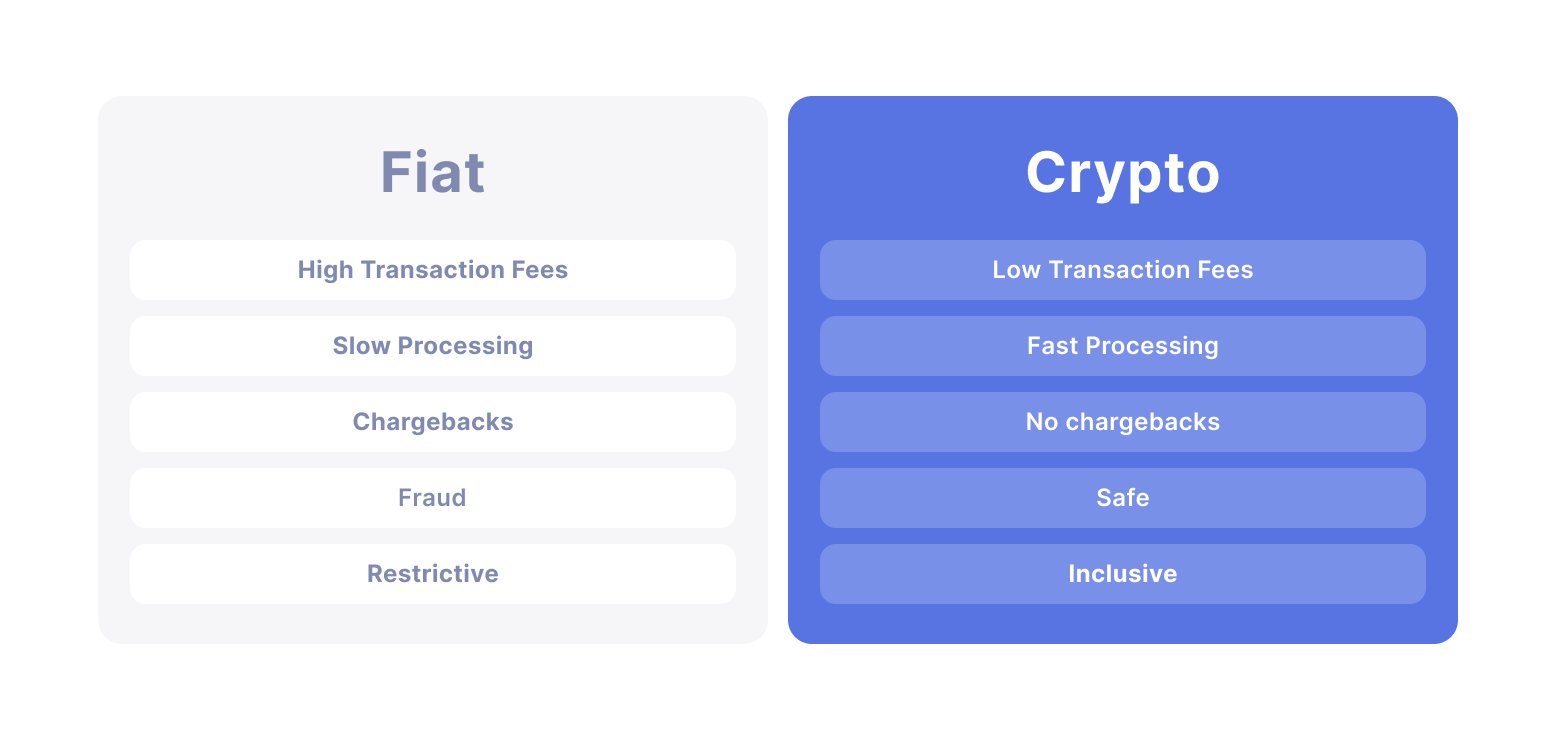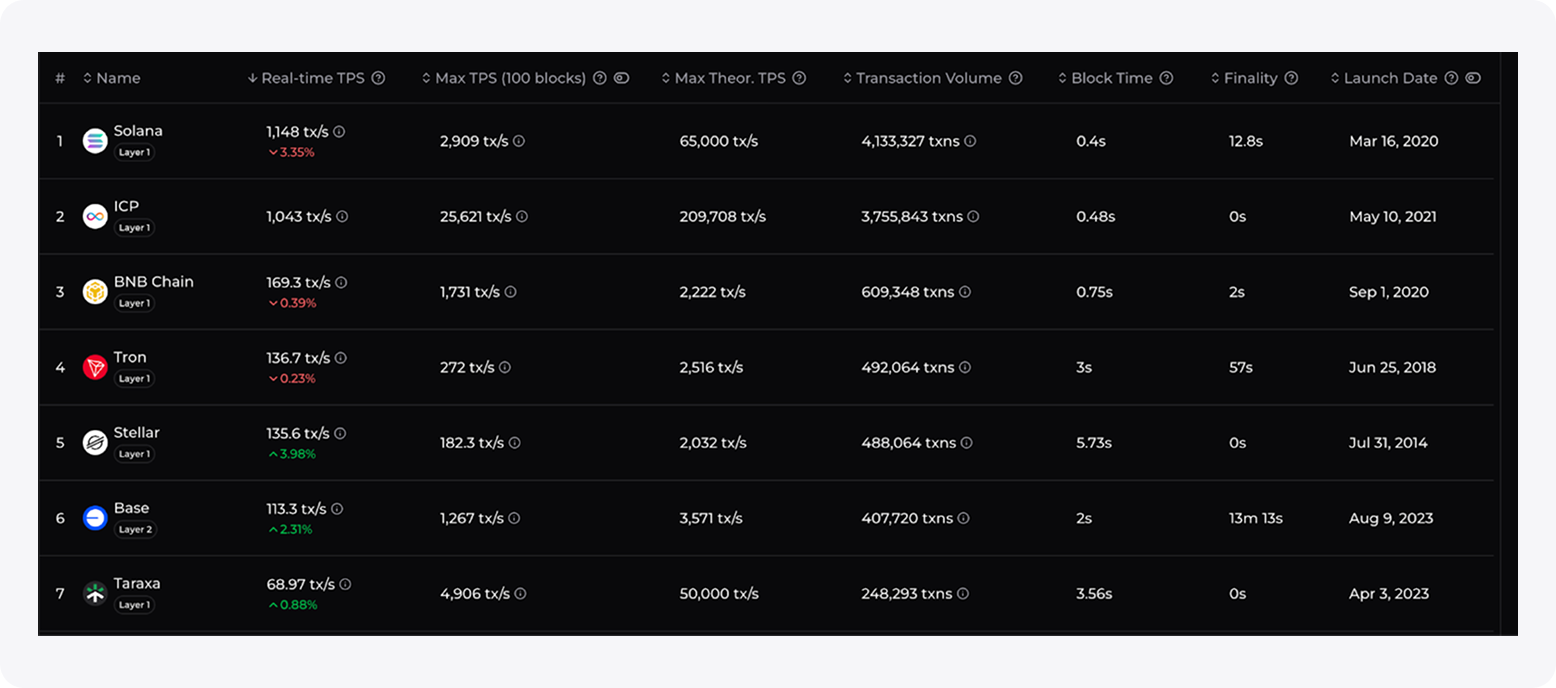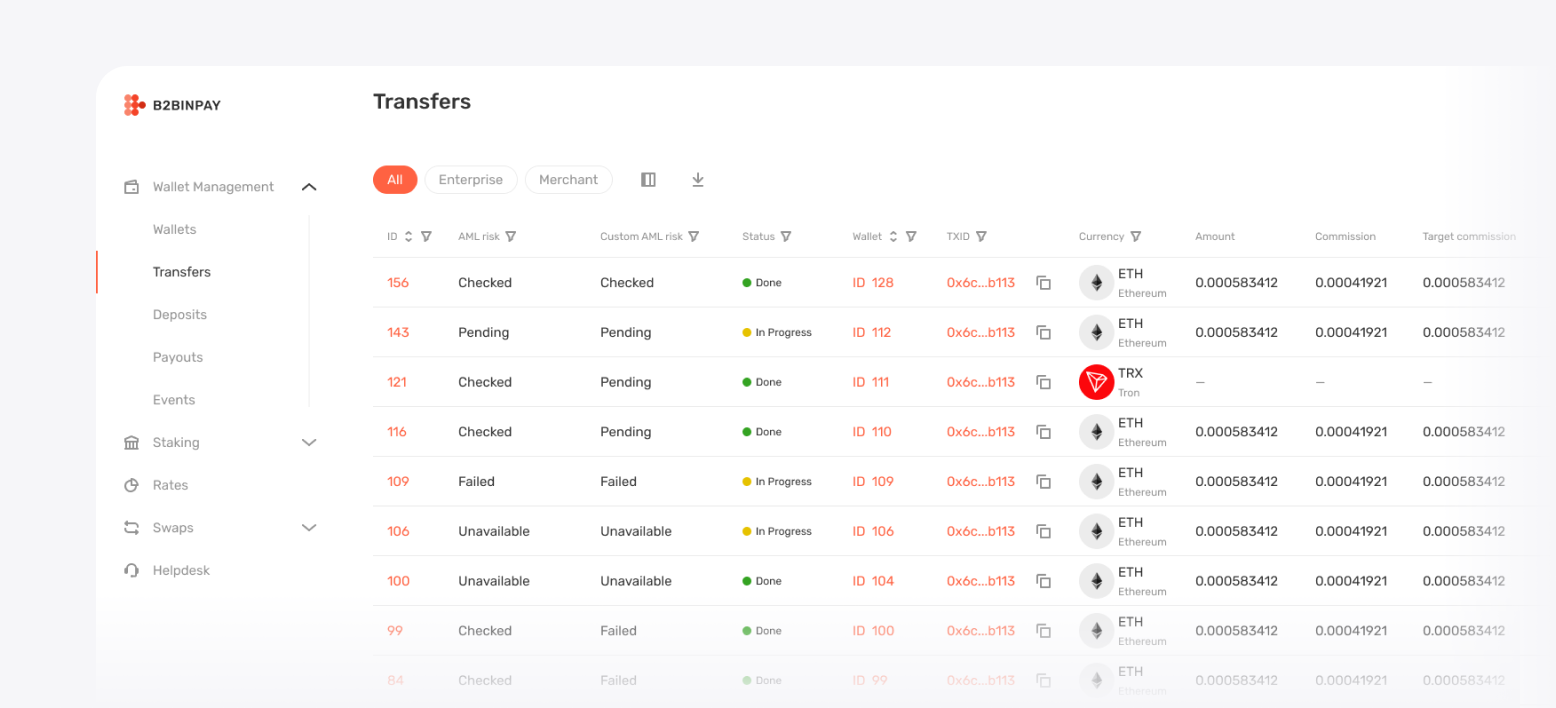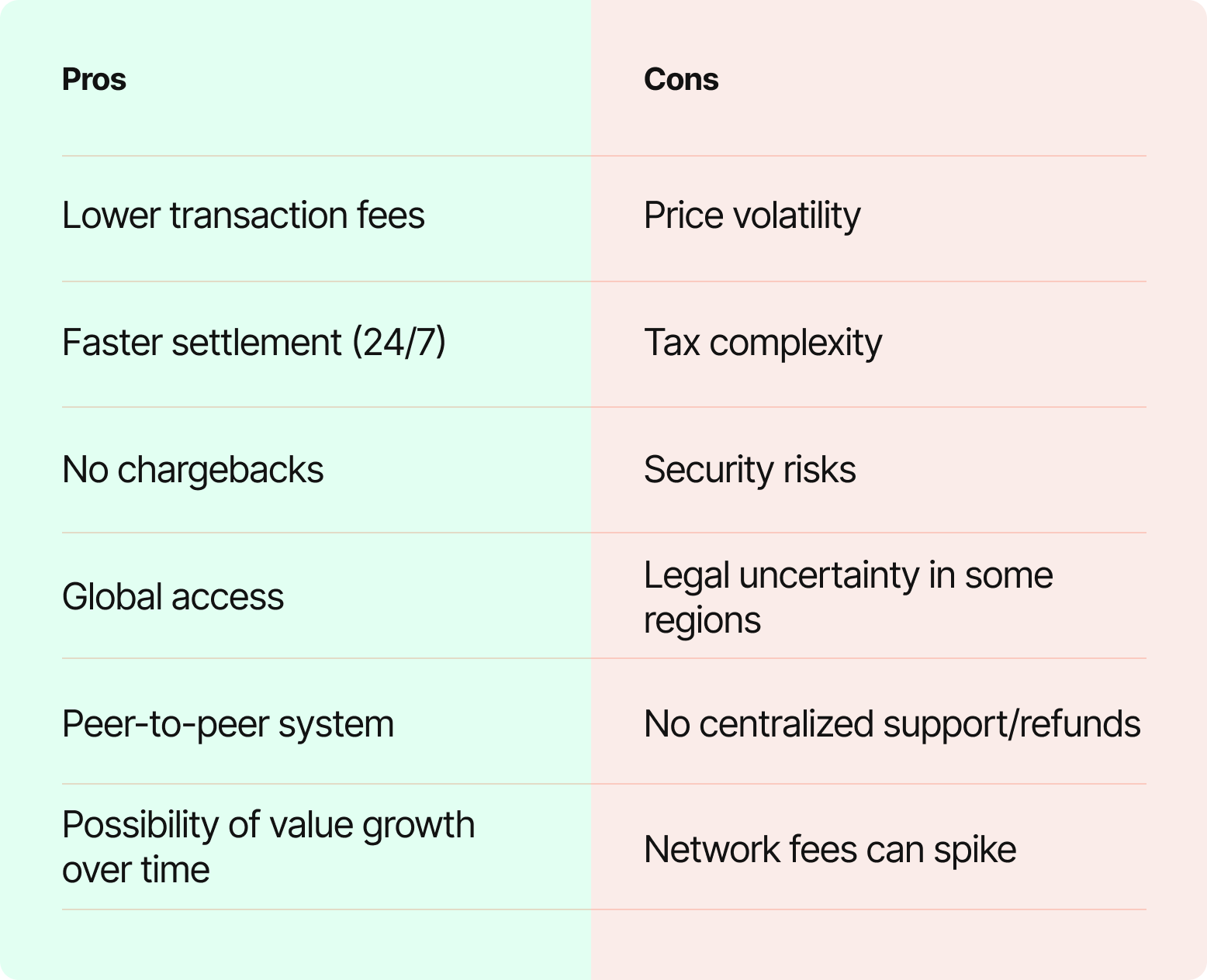As digital currencies continue to gain popularity across industries, more businesses are wondering if they should also accept payments in crypto. The deafening headlines in the media about Bitcoin's price fluctuations or blockchain are oftentimes misleading. Before making the decision, it’s crucial to understand how cryptocurrency functions as a payment method.
Benefits of Using Cryptocurrency as a Method of Payment
From a niche, unexplored asset to a viable financial tool, cryptocurrency continues to evolve. However, some businesses, particularly SMEs, still wonder, “What are some benefits of using cryptocurrency as a method of payment?” There are many, though the main advantage is that crypto helps streamline business operations and improve the customer experience.

Lower Fees
One of the primary reasons companies opt to accept payments in crypto is to minimize payment processing costs. Traditional payment systems involve multiple intermediaries: banks, card networks, and processors. Each of them charges a fee, typically ranging from 2% to 4% per transaction.
In contrast, cryptocurrency transactions run on decentralized networks. They don’t require banks, card networks, or payment processors to authorize and settle payments. Instead, transactions are verified by a distributed group of nodes using blockchain protocols and cryptographic techniques. This model helps businesses retain more revenue, especially in high-volume or cross-border environments.

Reduced Transaction Costs
Beyond lower fees, crypto payments also reduce other transaction costs, including currency conversion, cross-border surcharges, and settlement delays. Since crypto operates globally and isn’t tied to fiat money or central banks, it eliminates many hidden costs. For businesses, this can mean saving up to 3–5% on international B2B transactions and accelerating cash flow.
Instant Payments
Traditional payments, especially those made between countries, can take 3 to 5 business days to settle due to processing, time zone differences, and currency conversion. For example:
- Bank wire transfers (international): 3–7 business days
- ACH payments (U.S.): 1–3 business days
- Card settlements: 2–5 business days
Cryptocurrency transactions, on the other hand, often settle within minutes or even seconds. This instant settlement helps businesses avoid delays and receive payments without waiting for bank approvals or working hours.

Fraud Protection
Alongside speed, cryptocurrency payments offer enhanced fraud protection. In traditional systems, customer data—card numbers, personal information, bank account details—is stored on centralized servers, which can become a target for hackers. If breached, this information can be stolen, sold, or used for identity theft.
In this aspect, crypto transactions are a safer bet as they do not transmit sensitive personal information—transactions are anonymous and decoded. Payments are verified through encryption algorithms and stored on a public ledger, making them more secure and less susceptible to manipulation.
Irreversible Transactions
Another advantage—which, for some, can also be a drawback—is the irreversibility of crypto transactions. Once confirmed, they cannot be undone.
This protects merchants from chargeback fraud, a common issue in traditional payment systems where customers dispute payments after receiving goods. This brings more financial certainty for sellers, but at the same time, it also requires clear refund policies, as reversing a crypto payment depends entirely on the recipient.
Transparency
Transparency is another key benefit of cryptocurrency payments. Every transaction is recorded on a public ledger, allowing both the sender and the recipient to verify it at any time. This visibility reduces the risk of manipulation or disputes. It also helps businesses maintain accurate financial records, particularly during audits or when managing high transaction volumes.

Privacy and Anonymity
Unlike traditional payment methods that require names, card numbers, or billing details, anonymous transactions in cryptocurrency don’t expose personal data. Instead, payments are sent to public wallet addresses, for example, long strings like 0x1iFW7YRbNANd78rSALLtFPAutp1sW2LyqX.
To simplify this, users can link them to Web3 usernames, such as MyName.eth, which are easier to remember and share. This protects privacy and reduces the risk of data misuse or identity theft.

Peer-to-Peer
Peer-to-peer (P2P) crypto payments remove the need for banks or third-party processors. Here's how it works:
- The sender enters the recipient’s crypto wallet address or Web3 username.
- The amount is confirmed and sent directly via a blockchain.
- The recipient receives the funds almost instantly.
This model makes borderless payments real, reducing costs and delays. Unlike regular bank transfers, which require intermediaries, clearing times, and high fees, P2P crypto payments settle in minutes. While users still need to find a recipient who accepts cryptocurrency, once that’s done, the transfer process is much more straightforward—only a wallet address is necessary.
Pay From Anywhere
To pay with crypto, all that’s required is a stable internet connection. There's no need to visit a bank, wait for business hours, or be tied to a specific location. You can send funds locally or internationally without delays. Since crypto works 24/7, it suits global teams, remote workers, and mobile-first businesses.
Investment Potential
Aside from a payment option, cryptocurrency also holds long-term investment potential. It is highly volatile; however, many digital assets have experienced dramatic increases in value over the past decade.
The most famous story dates back to 2010, when a programmer Laszlo Hanyecz paid 10,000 BTC for two pizzas. At the time, the total cost was about $41. In 2024, the same amount of Bitcoin was worth $69,181, making pizzas worth almost $700 million!
There’s another case with Ethereum. Launched in 2015, ETH traded for less than $1 in its early months. By late 2021, its price surpassed $4,000, marking an increase of more than 400,000%. Early supporters who received ETH through project funding or development payments saw substantial appreciation, with no speculative investment involved.
For businesses, this presents a unique opportunity: accepting crypto mean acquiring appreciating assets. While no returns are guaranteed, and volatility is high, history shows that simply accepting specific cryptocurrencies at the right time has made a significant difference in the financial outcomes of both individuals and companies.
Disadvantages of Using Cryptocurrency as a Method of Payment
Despite their growing appeal, cryptocurrency payments come with certain risks and limitations. Businesses exploring this option should carefully weigh what are some disadvantages to using cryptocurrency as a payment method. Understanding these drawbacks is crucial for making informed and responsible decisions.
Security Issues
As mentioned, crypto payments remove intermediaries, but that also shifts the responsibility for security to the user. Unlike a bank account, there's no way to freeze or recover stolen funds. Losing private keys results in permanent loss of access. Hacking, phishing scams, and fake platforms continue to pose significant threats in the cryptocurrency market, particularly for newcomers to the niche.
Price Volatility
One of the core characteristics of cryptocurrency is its rapid price fluctuation. While it creates upside for investors, it poses challenges for everyday transactions. Crypto received as payment may drop sharply in value within a short time. This makes it difficult to price goods accurately or manage short-term cash flow, issues that don’t exist with fiat currency or traditional payment systems.
Tax Implications
Using crypto for payments can trigger complex tax implications. In many countries, including the U.S., crypto assets are treated as property, not currency, meaning every financial transaction may result in a capital gains tax. Businesses must track each transaction’s fair market value at the time of receipt. With unclear or changing regulations, staying compliant can be time-consuming and difficult.

Cryptocurrency Regulations
Cryptocurrency regulations remain inconsistent around the world, which causes uncertainty for businesses. In the United States, crypto is legal but regulated as property by the IRS and as a security by the SEC in certain cases. In the European Union, the MiCA framework is moving toward unified crypto regulation, but rules vary between member states until it’s fully in force.
Other countries take more restrictive approaches. China has banned crypto trading and mining entirely, classifying digital currencies as a threat to financial stability. India permits crypto holding and trading, but proposed tax policies and unclear regulations have made it a challenging environment for crypto businesses.

In short, what’s entirely legal and encouraged in one market may be restricted or penalized in another. Therefore, businesses must closely monitor local laws to remain compliant and avoid legal or financial risks.
Not Reversible
As mentioned earlier, crypto transactions are irreversible, which can be both a strength and a weakness. For merchants, it protects against chargeback fraud. But for users, it leaves no recourse if funds are sent to the wrong cryptocurrency wallet or a scammer. There’s no bank or central authority to reverse the transaction. Once it’s confirmed, it’s final. This adds pressure to double-check every detail before sending.
Network Transaction Fees
Although crypto is often praised for lower fees, some blockchain networks can become congested, causing transaction fees to rise sharply. Users may pay more to speed up confirmation times, especially during peak periods on networks like Bitcoin or Ethereum. These fluctuations can create unpredictability in operating costs, particularly for businesses expecting stable processing fees.
How to Reduce Risks When Implementing Cryptocurrency
Now that we’ve covered both advantages and disadvantages of cryptocurrency payments, here are a few practical ways to reduce the risks involved in using them:
- Use a reputable payment processor with built-in security features like two-factor authentication and fraud monitoring.
- Convert crypto to fiat quickly to avoid exposure to price volatility.
- Train your staff to spot scams, phishing attempts, and unauthorized access.
- Limit accepted currencies to well-established tokens, such as BTC or ETH.
- Track transactions accurately for tax and compliance reporting.
- Stay informed on evolving regulations in each operating region.
Conclusion
As we’ve seen, accepting cryptocurrency payments can offer real advantages—faster settlements, lower fees, and global access. But it also comes with specific risks: volatility, tax complexity, and inconsistent regulations. For businesses, the key is weighing the pros and cons carefully and implementing safeguards to manage risk. With the right approach, crypto can be a robust and future-proof payment option.
What Are the Pros and Cons of Crypto Payments?

Crypto payments combine efficiency with autonomy. But they also require a more proactive approach to risk management, compliance, and operational processes than traditional currencies.
What Stands Out as the Biggest Advantage of Using Cryptocurrency?
The major benefit of using crypto for payments is control. Businesses aren’t dependent on banks, card networks, or third-party platforms to send or receive funds. Transactions settle instantly, fees are often lower, and payment rails are open 24/7 across borders. For companies operating globally—or those looking to future-proof their operations—crypto offers a level of independence that traditional systems can’t match.



.svg)







